

New Tab. Envisioning a DIY CyberCarpet for Omnidirectional Motion. The CyberCarpet is the only omnidirectional stationary motion system that is anywhere near practical for consumer VR.
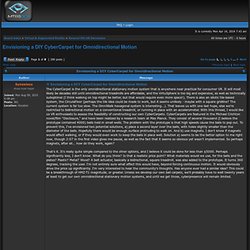
It will most likely be decades still until omnidirectional treadmills are affordable, and the VirtuSphere is too big and expensive, as well as technically suboptimal (I think walking on top might be better, but that would require even more space!). There is also an idiotic tile-based system, the CirculaFloor (perhaps the tile idea could be made to work, but it seems unlikely - maybe with a square gridline? The current system is far too slow. The OmniWalk hexagonal system is interesting...). That leaves us with one last hope, else we're restricted to bidirectional motion on a conventional treadmill, or running in place with an accelerometer.
That's it. MBT-5/8 CS Solid Machined Ball Transfer Unit 5/8" Main Ball USA made Ball Bearings. MBT-5/8 CS Solid Machined Ball Transfer Unit, Main Ball is 5/8" Inch, 5/8" Main ball rotates on 1/8" support balls, MBT-5/8 CS is integral flange at top allows unit to be dropped into 1" diameter hole.

Item: MBT-5/8 CS Bearing Type: Ball Transfer unit Ball Material: Carbon Steel Housing Material: Carbon Steel Load Capacity: 33 LBS Quantity: One Bearing Brand: Hudson Bearings Made in the USA. [backordered] 2 Holes Flange Ball Transfer Unit Mounted Bearings. Green Exercise: Manual Treadmill Requires No Electricity. Since it's getting chilly out, walking or running outside may seem less and less appealing.

You can buy an expensive motorized treadmill or spend lots of money on a gym membership, but if you want a cheaper or greener option, a manual treadmill may be just the thing you're looking for. These treadmills have no motor and use no electricity. All it takes is your muscle power to get the belt moving, which means it's good for your body and the environment. Not only that, but it makes much less noise so you can listen to music or watch TV and be able to hear without having to wear headphones. How To Build A Manual Treadmill. Manual treadmills are relatively uncomplicated in terms of design.
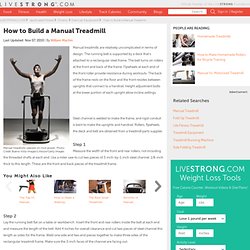
The running belt is supported by a deck that's attached to a rectangular steel frame. The belt turns on rollers at the front and back of the frame. Flywheels at each end of the front roller provide resistance during workouts. The back of the frame rests on the floor and the front resides between uprights that connect to a handrail. Height adjustment bolts at the lower portion of each upright allow incline settings.
Steel channel is welded to make the frame, and rigid conduit is bent to make the uprights and handrail. Measure the width of the front and rear rollers, not including the threaded shafts at each end. Lay the running belt flat on a table or workbench. How to Build a Manual Treadmill. Omnidirectional treadmill News, Videos, Reviews and Gossip - io9. Omnidirectional Treadmill / Virtual Reality Floor. OMNIDIRECTIONAL TREADMILL - Reviews & Brand Information - David Carmein Ann Arbor , - Serial Number: 78199392. Omni-directional Treadmills Could Allow You to Roam Virtual Environments « Road to Virtual Reality. An omni-directional treadmill is just like your traditional gym treadmill, except instead of only being able to go forward, you can move in any direction.
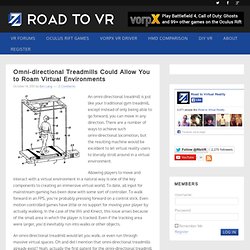
There are a number of ways to achieve such omni-directional locomotion, but the resulting machine would be excellent to let virtual reality users to literally stroll around in a virtual environment. Allowing players to move and interact with a virtual environment in a natural way is one of the key components to creating an immersive virtual world. To date, all input for mainstream gaming has been done with some sort of controller.
To walk forward in an FPS, you’re probably pressing forward on a control stick. Even motion controlled games have little or no support for moving your player by actually walking. MSE Weibull - the training equipment specialist - Home. CyberWalk: Giant Omni-Directional Treadmill To Explore Virtual Worlds. It's a problem that has long annoyed virtual reality researchers: VR systems can create a good experience when users are observing or manipulating the virtual world (think Michael Douglas in "Disclosure") but walking is another story.
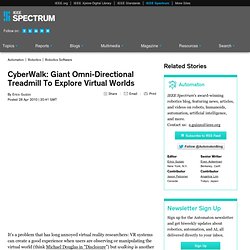
Take a stroll in a virtual space and you might end up with your face against a real-world wall. The same problem is becoming apparent in teleoperated robots. Imagine you were teleoperating a humanoid robot by wearing a sensor suit that captures all your body movements. You want to make the robot walk across a room at the remote location -- but the room you're in is much smaller. Hmm. VirtuSphere. The VirtuSphere is a creation of Ray and Nurulla Latypov, whose company, VirtuSphere Inc, is based in Binghamton, New York.[2][3] Using the VirtuSphere simulator Applications[edit] Markets and applications for Virtusphere include:[4] Military, law enforcement, and other dangerous occupations that require a safe training environmentGaming and entertainmentHealth and fitnessMuseums and other educational installationsVirtual tours of architectural and construction projects VirtuSphere was showcased at IIT Bombay's annual technical festival, Techfest in 2011.[6]

CyberWalk. Stewart platform. An example of a Stewart platform Name of the device[edit] Two hexapod positioners Designed by Gough and Stewart[edit] This specialised six-jack layout was first used by V E (Eric) Gough of the UK and was operational in 1954,[1] the design later being publicised in a 1965 paper by D Stewart to the UK Institution of Mechanical Engineers.[2] Although the short title Stewart Platform is now used for this jack layout, it would be fairer to Eric Gough to call it a Gough/Stewart platform.
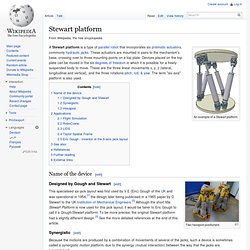
To be more precise, the original Stewart platform had a slightly different design.[3] See the more detailed references at the end of this article. Synergistic[edit] Because the motions are produced by a combination of movements of several of the jacks, such a device is sometimes called a synergistic motion platform, due to the synergy (mutual interaction) between the way that the jacks are programmed. Omnidirectional treadmill. U.S.
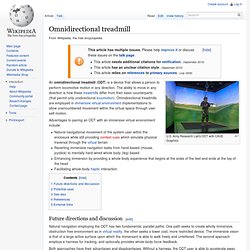
Army Research Lab's ODT with CAVE Graphics Advantages to pairing an ODT with an immersive virtual environment include: Natural navigational movement of the system user within the enclosure while still providing context cues which simulate physical traversal through the virtual terrainReverting immersive navigation tasks from hand-based (mouse, joystick) to mentally hard-wired whole body (leg) basedEnhancing immersion by providing a whole-body experience that begins at the soles of the feet and ends at the top of the headFacilitating whole-body haptic interaction Future directions and discussion[edit] Natural navigation employing the ODT has two fundamental, parallel paths.
Both approaches have their advantages and disadvantages. With a harness, the user is kept on center mechanically, and the surface area can be made much smaller.